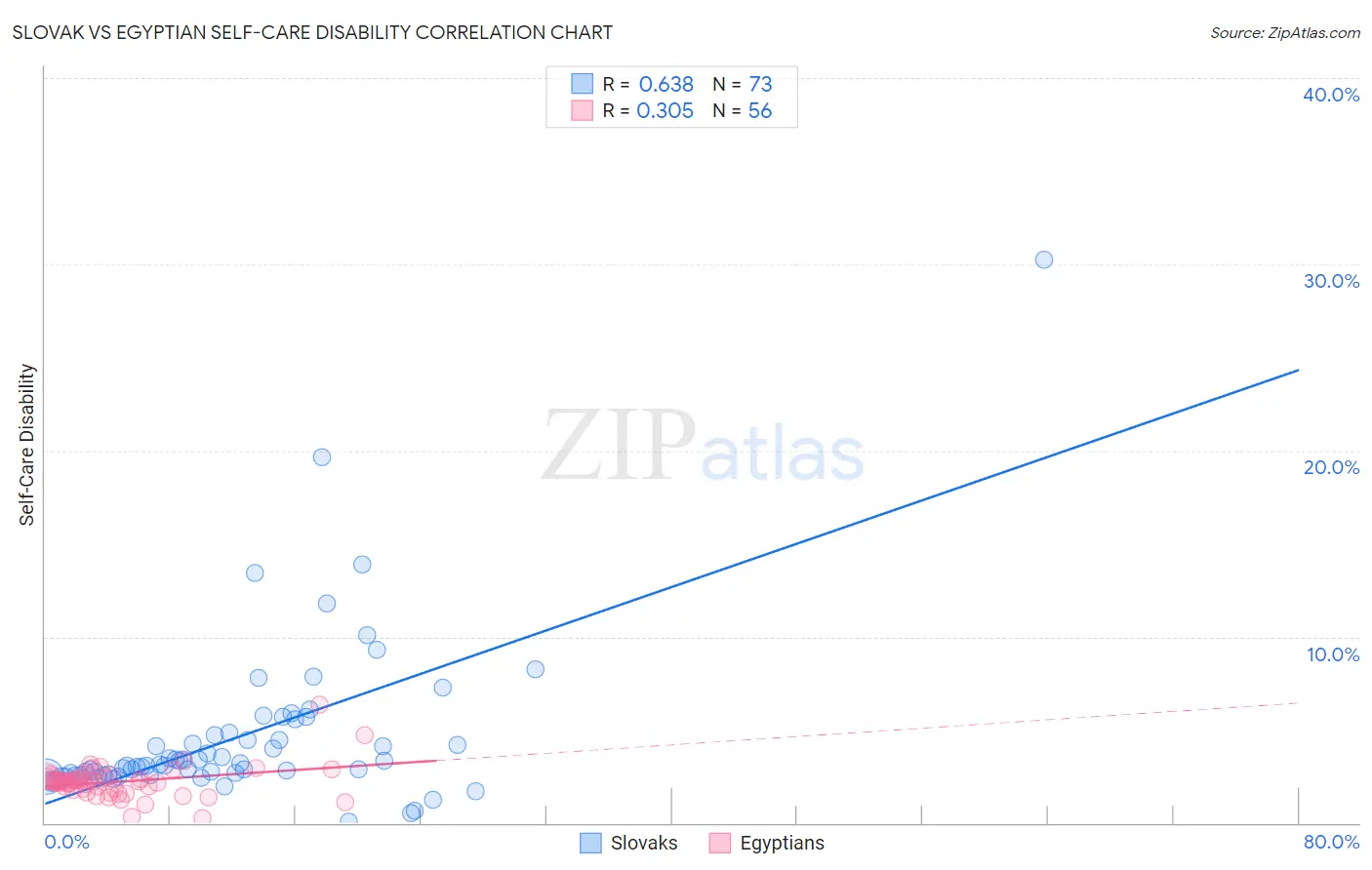Slovak vs Egyptian Self-Care Disability
COMPARE
Slovak
Egyptian
Self-Care Disability
Self-Care Disability Comparison
Slovaks
Egyptians
2.5%
SELF-CARE DISABILITY
12.6/ 100
METRIC RATING
202nd/ 347
METRIC RANK
2.3%
SELF-CARE DISABILITY
99.4/ 100
METRIC RATING
62nd/ 347
METRIC RANK
Slovak vs Egyptian Self-Care Disability Correlation Chart
The statistical analysis conducted on geographies consisting of 397,370,448 people shows a significant positive correlation between the proportion of Slovaks and percentage of population with self-care disability in the United States with a correlation coefficient (R) of 0.638 and weighted average of 2.5%. Similarly, the statistical analysis conducted on geographies consisting of 276,732,950 people shows a mild positive correlation between the proportion of Egyptians and percentage of population with self-care disability in the United States with a correlation coefficient (R) of 0.305 and weighted average of 2.3%, a difference of 8.9%.

Self-Care Disability Correlation Summary
| Measurement | Slovak | Egyptian |
| Minimum | 0.091% | 0.26% |
| Maximum | 30.2% | 6.4% |
| Range | 30.1% | 6.1% |
| Mean | 4.6% | 2.2% |
| Median | 3.1% | 2.2% |
| Interquartile 25% (IQ1) | 2.6% | 1.8% |
| Interquartile 75% (IQ3) | 4.8% | 2.4% |
| Interquartile Range (IQR) | 2.2% | 0.61% |
| Standard Deviation (Sample) | 4.4% | 0.90% |
| Standard Deviation (Population) | 4.4% | 0.89% |
Similar Demographics by Self-Care Disability
Demographics Similar to Slovaks by Self-Care Disability
In terms of self-care disability, the demographic groups most similar to Slovaks are Immigrants from Lebanon (2.5%, a difference of 0.020%), Immigrants from South Eastern Asia (2.5%, a difference of 0.030%), Immigrants from Western Africa (2.5%, a difference of 0.070%), Immigrants from Bahamas (2.5%, a difference of 0.080%), and Immigrants from Russia (2.5%, a difference of 0.18%).
| Demographics | Rating | Rank | Self-Care Disability |
| Immigrants | Southern Europe | 15.6 /100 | #195 | Poor 2.5% |
| Koreans | 15.5 /100 | #196 | Poor 2.5% |
| Crow | 15.2 /100 | #197 | Poor 2.5% |
| Immigrants | Immigrants | 15.0 /100 | #198 | Poor 2.5% |
| Immigrants | Ghana | 14.7 /100 | #199 | Poor 2.5% |
| Immigrants | Western Africa | 13.3 /100 | #200 | Poor 2.5% |
| Immigrants | South Eastern Asia | 12.9 /100 | #201 | Poor 2.5% |
| Slovaks | 12.6 /100 | #202 | Poor 2.5% |
| Immigrants | Lebanon | 12.4 /100 | #203 | Poor 2.5% |
| Immigrants | Bahamas | 11.9 /100 | #204 | Poor 2.5% |
| Immigrants | Russia | 11.0 /100 | #205 | Poor 2.5% |
| Alaskan Athabascans | 10.4 /100 | #206 | Poor 2.5% |
| French | 9.9 /100 | #207 | Tragic 2.5% |
| Central Americans | 8.7 /100 | #208 | Tragic 2.5% |
| Malaysians | 7.7 /100 | #209 | Tragic 2.5% |
Demographics Similar to Egyptians by Self-Care Disability
In terms of self-care disability, the demographic groups most similar to Egyptians are Palestinian (2.3%, a difference of 0.090%), Mongolian (2.3%, a difference of 0.090%), Swedish (2.3%, a difference of 0.090%), Brazilian (2.3%, a difference of 0.16%), and Immigrants from Japan (2.3%, a difference of 0.19%).
| Demographics | Rating | Rank | Self-Care Disability |
| Immigrants | France | 99.6 /100 | #55 | Exceptional 2.3% |
| Immigrants | Eastern Asia | 99.6 /100 | #56 | Exceptional 2.3% |
| Immigrants | Belgium | 99.6 /100 | #57 | Exceptional 2.3% |
| Immigrants | Cameroon | 99.6 /100 | #58 | Exceptional 2.3% |
| New Zealanders | 99.5 /100 | #59 | Exceptional 2.3% |
| Immigrants | Japan | 99.5 /100 | #60 | Exceptional 2.3% |
| Palestinians | 99.4 /100 | #61 | Exceptional 2.3% |
| Egyptians | 99.4 /100 | #62 | Exceptional 2.3% |
| Mongolians | 99.3 /100 | #63 | Exceptional 2.3% |
| Swedes | 99.3 /100 | #64 | Exceptional 2.3% |
| Brazilians | 99.3 /100 | #65 | Exceptional 2.3% |
| Immigrants | Argentina | 99.3 /100 | #66 | Exceptional 2.3% |
| South Africans | 99.3 /100 | #67 | Exceptional 2.3% |
| Immigrants | Zaire | 99.2 /100 | #68 | Exceptional 2.3% |
| Immigrants | Norway | 99.2 /100 | #69 | Exceptional 2.3% |